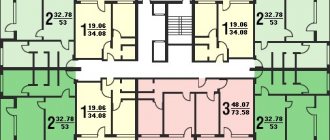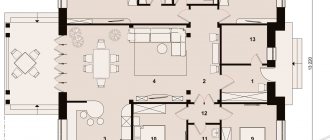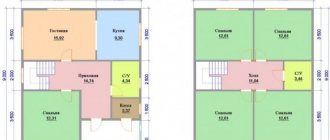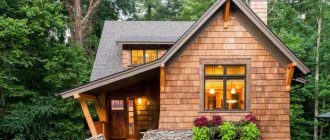An architect explains how a good 1,000-apartment building differs from a bad one
How does a well-designed 1,000-unit building differ from a poorly designed one? Why are elevators noisy? Are garbage chutes necessary? And which floor is better to live on? Vladimir Linov, architect, associate professor of St. Petersburg State University of Architecture and Civil Engineering, answers these and other questions.
– People in new (usually monolithic) houses often complain about poor sound insulation: elevators rattle, you can hear neighbors using the garbage chute. Is this something a designer can struggle with when designing?
– As for sound insulation, the “acoustic well-being” section is mandatory in projects. For example, interfloor ceilings must have sound-absorbing pads. The elevator shaft must be separated from the housing by seams, where soundproofing strands must be laid.
The contractor can simplify the solution by using cheaper material, and then the most audible impact noise transmitted through concrete structures penetrates into the apartments.
Elevators require designer supervision. Construction debris, such as lumps of cement, often gets caught in the seams between the elevator shaft and surrounding structures. Noise is transmitted through them better than through emptiness.
The quality of the elevator is important. The cheapest elevators of the Mogilev plant have become the talk of the town among designers.
– Is it necessary to include a garbage chute in the project? They smell!
– According to modern standards, garbage chutes need not be built. Including in tall buildings. These devices have long been no longer considered a sign of comfort; they become clogged with garbage, and rats can climb the walls to any height. It is necessary to clean the garbage chutes weekly with hot steam, which in itself is difficult and expensive. In many buildings, waste chute hatches are welded shut.
But the problem of sorting waste at sites in the courtyards of apartment buildings remains.
– What problems do architects have to solve when designing residential buildings with 1000 apartments? What does an architect want to do but can't?
– These are classic problems of size and proportions, everything that is included in the concept of beauty. Architects spend a lot of time on facades - rhythms, color, plasticity.
But the number of protrusions, which determines the external expressiveness of the facades, harms the efficiency of the building. The author of the project has to constantly monitor himself. Simply put, rooms should not protrude too much from the main volume.
In general, the absolute majority of architects are supporters of the European type of development: 6–7 floors with good facade finishing, greenery and landscaping. If we talk about the coefficient of use of the territory (the ratio of the area of apartments to the area of land), then this is no more than 2. If we talk about population density, then no more than 400–450 people per hectare of residential territory. But in practice it almost always turns out differently.
– What is a residential area?
– Where are residential buildings, childcare facilities, local services, parking lots and driveways located? This does not include clinics, shopping centers, cultural institutions, etc.
– From an economic point of view, what shape should the building be?
– It is known that the ideal building in terms of heat loss per unit volume per unit surface is a sphere. But it is impossible to make an apartment building in the shape of a ball.
Among the more practical solutions, the building should have a wide body plan, which is more economical during construction and especially during further operation. Architects think about this, even without always discussing this topic with the client.
– Who determines the apartment layout, the number of apartments, their footage – the developer or the architect?
– Developers are demanding to squeeze out as much housing as possible on the land they purchased. Architects are required to use tricks when calculating the number of residents, accordingly, saving on social services and greenery.
– How does this happen in practice?
– According to existing standards, there should be 28 square meters per person. Developers write to the expert that they will have 40 meters, and sometimes 45 meters per person.
No one really knows what the actual occupancy will be. In the economy class there is not even 28, there may well be 25. Relatively inexpensive housing is extremely densely populated; people take out a serious mortgage to buy it.
As for the layout of an apartment building, customers are now demanding the maximum output of one-room apartments and studios. It is necessary to ensure regulatory insolation, then it is clear that such an apartment faces one side.
In Leningrad in the 1970s, exotic schemes were tested, with a one-room apartment facing two sides: the kitchen on one side, the room on the other. I know two such houses - on the street. Tukhachevsky and others. The Unconquered. Such buildings require a complex arrangement of apartments on each floor.
– Who determines how many apartments will go onto one landing?
– The architect can determine the type of section layout (how many apartments go onto one landing) – from the usual 4 to 5-8, or even up to 12 apartments. When the house is located from north to south, the apartments face east and west, and a long inter-apartment corridor is created between them. But it is limited by the norm: from any apartment door to the stairs there should be no more than 12 meters, and the section area should not be more than 500 square meters. meters with one staircase.
– How do you solve the problem of parking during design?
– According to the standards, there should be one parking space per 80 square meters. meters of housing. Although it is clear that if these 80 meters have two one-room apartments or three studios, then there will be two or three cars there. The most rational way to solve this problem is ground-based multi-story parking lots; they greatly save territory. But developers prefer not to build them, even if they are included in the project.
- Why?
– Due to low demand. Residents prefer to park their cars on the lawn. This is already a control problem. Another way is surface parking; they eat up space. The third is underground parking on one or several levels. It is expensive, and multi-storey underground parking is beyond economics for economy class housing.
– So, if you tie parking to the price of an apartment, it will turn out to be uncompetitive in the market?
- Not so simple. Much depends on the specific territory. For example, on the Petrograd side, where housing construction is currently underway, I think this is possible.
– What solutions for building materials are most often used now?
– Monolithic reinforced concrete for walls and ceilings; panels are widely used for external and internal walls. In small quantities - panels with a fine finish.
The facade begins to be insulated with mineral wool slabs, and a fine finish is applied to them. Sometimes facades are ventilated with air movement between the finishing slabs and insulation. Flat roof with waterproofing and insulation.
Reinforced concrete is an iron cage that shields the natural magnetic field, which is unfavorable for health. But I don’t know of any serious research on this topic.
The quality of finishing materials for floors and walls is important. It is bad if they use cement, which in developed countries is considered an unfavorable material for housing.
On the contrary, gypsum, that is, gypsum sheets, is a favorable material. And, of course, wood, which is rarely used in our country. Even floors are not always made from it.
“You can’t build a skyscraper out of wood!”
– In the world (the Scandinavians began) they began to build, for now as an experiment, 10-16-story all-wooden houses. They try to get by with a minimum of iron, using traditional methods of wooden fastenings.
– Is continuous glazing of facades good?
– It is possible, but the details require discussion. The first problem is that the orientation of the glass facade to the south and west will cause overheating of the room. And not only in summer, but even in winter. All energy-saving houses are built on this effect.
– But in St. Petersburg there are only 60 sunny days a year.
“Two months of suffering is also a lot.” This means that expensive glass is required, they are 10 times more expensive. Or it is necessary to install ventilation devices for rooms where overheating is possible. This is how energy-saving houses are built in world practice. They use lamellas - structures that rotate depending on the position of the sun. But in our climate they freeze in winter and stop working. This is not a St. Petersburg decision. Economically and from the point of view of comfort, such a façade with continuous glazing is undesirable. From an aesthetic point of view, there may be different opinions.
– Are original solutions possible when designing mass housing?
– Original solutions, in my understanding, are quality solutions. This is a new development on Medikov Avenue, reminiscent of the Scandinavian experience, low-rise buildings, semi-enclosed courtyard spaces, high-quality apartment layouts, good landscaping, simple facades with multi-colored ceramic cladding and synthetic plaster.
In the “Baltic Pearl” both the general layout of the blocks and the layout of individual buildings and apartments are successful. “Finnish Quarters” is interesting according to the same parameters. They are located outside of St. Petersburg, but apartments there are cheaper. Everything I mentioned refers to comfort-class housing.
– How do you understand the difference between comfort and economy?
– I would not focus on the area of the apartment. I'll pay attention to the size of the bathroom. For comfort in a three-room apartment, two bathrooms are required, one combined with a bath and located in the sleeping area. This does not greatly increase the total area of the apartment, but significantly improves its consumer qualities.
Another important parameter is the size of the kitchen. It should start from 12 square meters. meters. In economy - no more than 10. With careful planning, a difference of two meters is very significant.
– It is generally accepted that dense high-rise buildings are the only way to maintain the cost per square meter of housing. This is true?
– For the last 50 years, endless cost calculations have been carried out for different building heights. So, if everything is done strictly according to the norms and rules, then houses with a height of more than 9 floors turn out to be more expensive even in construction, not to mention operation. Tall buildings require more powerful structures, more expensive engineering systems, pumps, etc.
I will name a problem that is little known to consumers. At heights above 9 floors, so-called smoke-free staircases are required. It is necessary to make sure that from the inter-apartment corridor through a special passage it is possible to exit to an open balcony, and from it to the staircase. As a rule, it is not heated and cannot be used.
I'm not even talking about special shafts for pressurizing air in case of fire, as well as automatic smoke removal systems, which usually do not work and rust. But in the event of a fire, they must be automatically turned on from independent power sources. And all this costs money.
– Why then are they building houses with 25 floors?
– Developers are not concerned about operating costs. They build, sell and leave, most often without creating management companies, as they should always have done.
It is precisely such a high height that makes it possible to fill the territory with square meters and quickly recoup expenses.
– Is there an alternative to anthills in our economic conditions?
– Only administrative control over the developer. As soon as he is no longer able to speculate on the number of residents, but truly fulfills the standards, 25-story buildings will not allow him to fulfill all the standards for social services, greenery, and parking. Then it will be profitable to build 8–9 floors at a density of 450 people per hectare.
– The new Land Use and Development Rules introduced a limit on the height of houses - 40 meters, or 13 floors. This is good!
“But a line immediately formed to overcome the maximum permissible height. In addition, all the houses are the same height of 13 floors - this is poor from an aesthetic point of view. They are no better than 25.
– If you were choosing an apartment for yourself, what floor would it be on?
– It greatly depends on the location, for houses on noisy streets: this is the third – fifth. If the apartment faces a quiet courtyard, then everything depends on the landscaping, security system and design solution.
Sometimes the project includes a small plot of land for the owners of apartments on the ground floor. This is a huge advantage and has been used in European countries since the 1930s.
If we talk about mass demand, then a lot depends not on the building, but on the person. It is known that 10% of people feel comfortable at high altitudes, from where they can see tens of kilometers around. And the other 10% suffer from a fear of heights and feel uncomfortable being above the 3rd or 4th floor.
Vadim Shuvalov
Jan Weiss "House of a Thousand Floors"
The reason I chose this book to read was because the abstract interested me. And one more thing - I decided to again try the dystopian genre, which this book is classified under, with which I am not very friendly. But this book went very easily. Perhaps because it has a very small volume - just a few hours of fascinating reading. Perhaps because there are no voluminous and lengthy descriptions of portraits and the surrounding space - everything is very clear, specific and purposeful, thanks to which all participants in the story look more than picturesque. Perhaps because the book is incredibly fast - there is not a moment of rest in it, not a single hesitation, there is one continuous action that began somewhere in the depths of a thousand-story building along with an invisible man named Peter Brock, who came from the stairs, who has no past . Perhaps all these components played a role and made this journey very exciting and amazing for me. Or maybe I just don’t understand this genre, in order to comprehensively evaluate the work, I’ll just say one thing - I really liked the book. I did not expect anything like this from a story written in the late 20s of the last century and which today looks so amazing, relevant and appropriate.
From page to page, like in a kaleidoscope, the pictures replace each other. The Author created so many images that make up a single picture in this work: slaves tortured and blinded by work, kidnapping people under the guise of being sent to other planets who are sold into slavery or sent to the oven, strange and grotesque villains, like the meowing and crowing Chulkov, the king of 50,000 stars, the armless Harpon or the old man Schwartz, the creator of the terrible gas SIO, Gedonia - the city of bliss, the industry of all kinds of pleasures, the revolution and barricades on the 490th floor, the blind prophet on the 794th, the atmosphere of confusion reigning on all floors where they rule rumors and the all-seeing Eye. All this, as if in a kaleidoscope, lives and flourishes in a house built and controlled by the Great Muller, where the sun has no power, where only Muller himself is the king, ruler and God, and only he decides when there will be day and night in the house. His name is pronounced here a thousand times a day, by many thousands of lips with trepidation, fear and reverence. It sounds like a spell and a victory cry. The lens in the ceiling is his eye - he sees everything and everyone, the microphone in the wall is his ear - he always hears everything, the crystal speaker is his mouth - his voice is heard unexpectedly and anywhere in the huge Muller-house, his hand can suddenly stick out from the ceiling - it is impossible to hide from him... What is he like - Ogisfer Muller? What kind of person - a man with a thousand faces? But I expected something similar when Brock saw his dressing room and himself.
This book mixes several genres: it is a detective story - you need to find and save a princess, it is an adventure with eavesdropping, spying and surveillance, it is an action movie with chases, shootouts and escape, it is also a philosophy - with an exposure and assessment of human vices and values, and Brock's great desire to break back into the real, free world.
Despite the rapid change of scenery and actions, the feeling of viscosity and immersion in something sticky did not let go, sucking in, as if it were the dream of a seriously ill person, with delirium, tossing about on a hot bed, a quick and incomprehensible whisper...
Spoiler (plot disclosure) ( click on it to see) As, indeed, it turned out. And when the eyes opened, all that remained was cold sweat, a rapid heartbeat and the gradual manifestation of thoughts in the gaze. Phew! Wow... ,,I saw a house with a thousand floors...”











